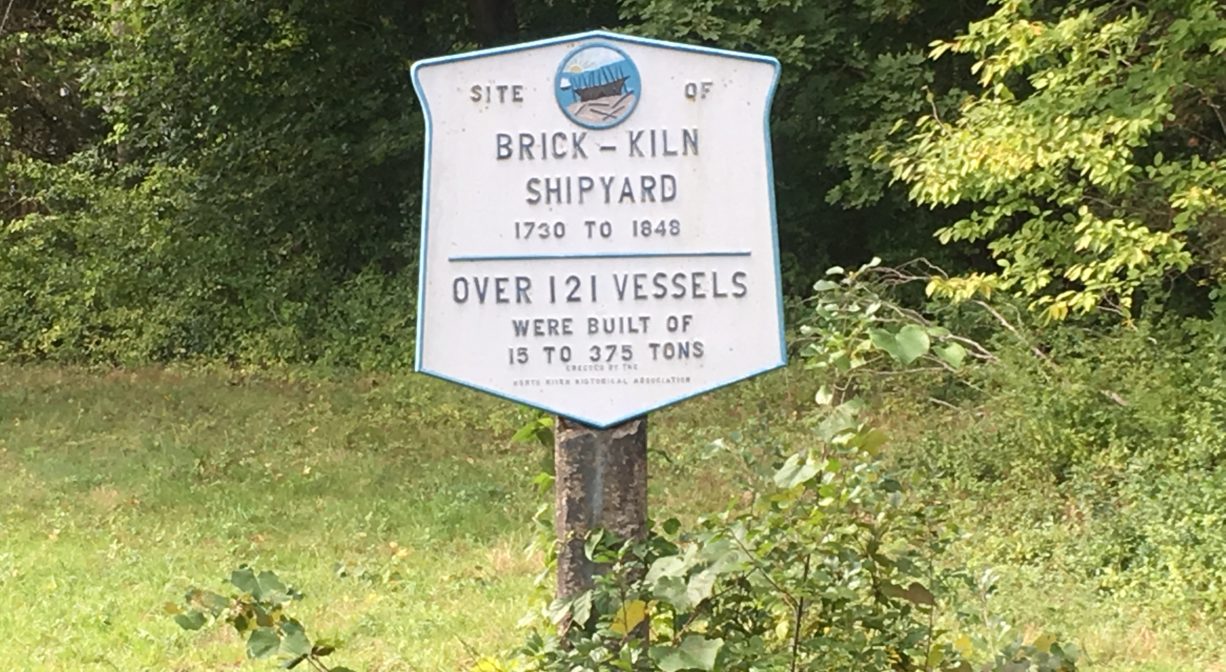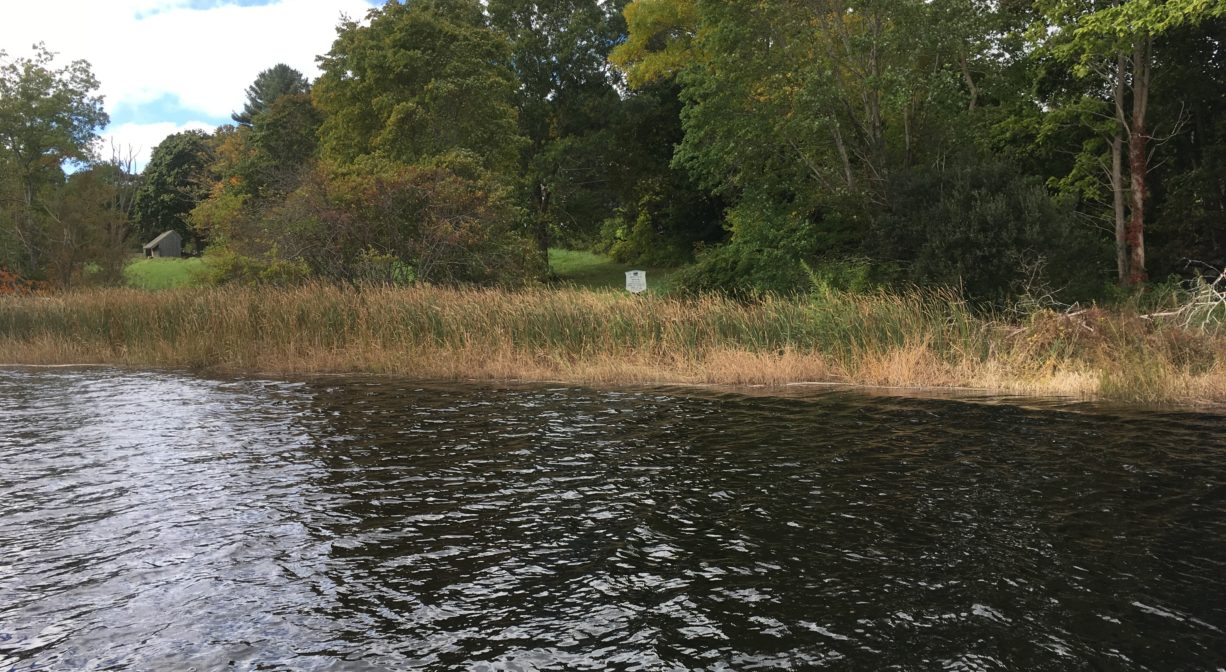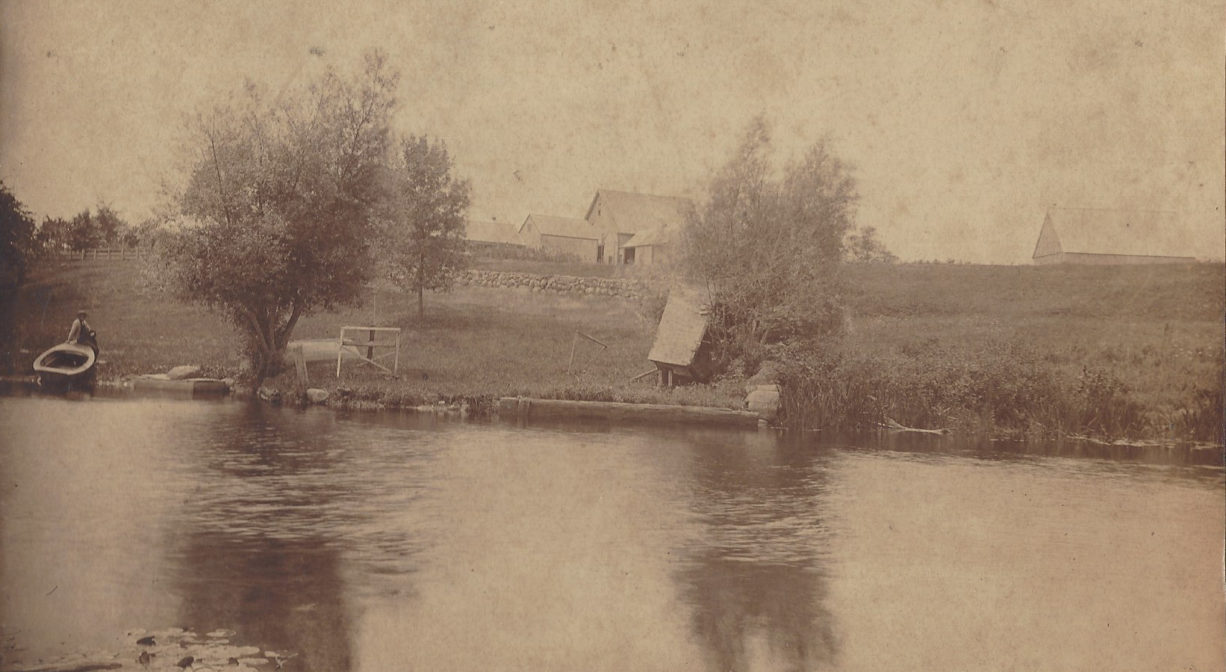Owned By: Privately owned.
The Brick Kiln shipyard was located at this spot on the North River in Pembroke from 1730-1848. It was an extremely active place, with two separate yards, often with three or four vessels under simultaneous construction, side by side. The Boston Tea Party ship Beaver was built here, as well as many other noteworthy vessels. The largest was “Laura Ann,” 375 tons, 103 ft. length, 14 ft. draft. The Maria, which is depicted on the Pembroke Town seal, was also constructed here.
This historic site is marked with a plaque that can be viewed from the water. No public access.
Features
It is likely that ships were built here prior to 1730, but no records exist. Pembroke was part of the town of Duxbury until it incorporated as its own municipality in 1711. Captain Benjamin Turner is the first shipbuilder on record to work at this site. Many noted shipbuilders served as his apprentices, including Ichabod Thomas.
Thomas is remembered especially for building one of the ships involved in the Boston Tea Party (December 16, 1773). Thomas built the Beaver, a whaler, at the Brick Kiln Yard. Commissioned by the prominent Rotch family of Nantucket, it measured 85 feet in length, with an almost 24 foot beam, and a draft of only nine feet, to accommodate Nantucket’s shallow harbor.
Captained by Hezekiah Coffin, the Beaver made its maiden voyage from Nantucket to London to deliver whale oil. As was customary, it took on a different cargo for its return, in this case some fine English furniture as well as 112 chests of tea from the British East India Company. After spending two weeks in quarantine in Boston Harbor, due to a case of smallpox on board, it finally docked at Griffin’s Wharf on December 15, 1773.
The next day, The Sons of Liberty, a group of more than 100 men from all walks of life, led by Samuel Adams, boarded the Beaver, as well as two other ships loaded with tea — the Dartmouth and The Eleanor. Being careful not to damage the ships, they smashed open 340 chests of tea (approximately 92,000 lbs.) and dropped them into the harbor, a significant act of protest in what would become the American Revolution. The Beaver returned to the whaling industry but was sold shortly thereafter.
Other shipbuilders active at Brick Kiln include (circa 1796): William Lewis, Alden, Luther & Elisha Briggs, Jonathan Sampson, Samuel Rogers and Isaac Hatch. Later, members of the Magoun, Turner and Briggs family worked here, among others. According to Pembroke: Ancient Trails to the 21st Century, Alden Briggs (1762-1849) made bricks with clay drawn from the clay pits behind his home, which is no longer standing, but was across the road from the shipyard site. The home of his brother, Luther Briggs, still stands at the shipyard site. Also of note, Theodore “Do” Macy operated a small boat storage and launching facility at this site from sometime after 1899 until his death in 1964.
The local shipbuilding industry sometimes employed slave labor. Both Boston and Newport were slave trading hubs, and some of the ships built on the North River were use in the slave trade.
Brick Kiln Yard was also a packet landing — one of many on the North River. In the book “Pembroke: Ancient Trails to the 21st Century,” Joseph Chetwynd describes packet landing construction as follows. “The landings were most likely built of crib-logs, back-filled with rocks and topped with gravel, with dead-man posts set up as bollards for tying up the vessels. These landings ran parallel to the shoreline and projected into the stream as little as was necessary so as not to impede the flow of traffic in the stream. They may also have incorporated vertical sheathing on the facing to act as fenders for the boats as they lay against the bulkhead.”
Packet ship lines were established prior to 1670, and thrived until railroads came to the South Shore in the mid-to-late 1800s. Over time, White’s Ferry, Little’s Bridge, Union Bridge, Hobart’s Landing, Foster’s Landing, Job’s Landing, Brick-Kiln Yard, and the North River Bridge in Hanover became regular stops. Farmers would meet the packet ship and barter their home-grown vegetables and dairy products for goods from China and Mediterranean, such as coffee, sugar and spices. In addition to home-grown goods, packet pilots also bought wood, fish, pot iron, and charcoal from locals, and sold them lumber and ship supplies. A typical packet run, up and down the river, could take three or four days.
This land is within the region of the Massachusett (or Massachuseuk) Native American tribe. The Mattakeeset band of the Massachusett lived for thousands of years in the North River watershed. Their village included most of today’s Pembroke and Hanson. To learn more about local Native American tribes, we encourage you to interact with their members. The Massachusett tribe at Ponkapoag and the Mattakeeset band of the Massachusett share information on their websites.
Habitats and Wildlife
There were 24 shipyards along the North River. Together they produced over 1,000 ships. All of those vessels were built with lumber culled from the surrounding forests. By the middle of the nineteenth century, few large trees remained. After the decline of the shipbuilding industry, the forests began to regenerate. Now, thanks in large part to conservation efforts, those forests have grown, providing essential wildlife habitat in the river corridor.
This property is located directly on the North River. The North River rises from marshes and springs in Weymouth, Rockland and Hanson. It is approximately 10 miles in length, with its source at the confluence of the Indian Head River (Hanover) and Herring Brook (Pembroke). From there it flows through the towns of Hanover, Pembroke, Marshfield, Norwell, and Scituate to the Atlantic Ocean between Third and Fourth Cliffs, draining approximately 59,000 acres along the way.
Historic Site: Yes
Park: No
Beach: No
Boat Launch: No
Lifeguards: No
Hours: Dawn to Dusk
Parking: View from the water only. No public parking or access.
Dogs: No
Boat Ramp: No
ADA Access: No
Scenic Views: Yes
Waterbody/Watershed: North River



